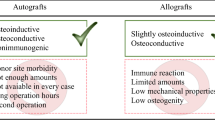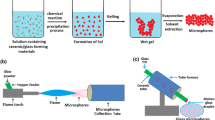Abstract
Hydroxyapatite is an elective material for bone substitution. In this outline of our recent activity the crucial role of nanostructured ceramics in the design and preparation of ceramic scaffolds will be described, focussing on our more recent interest in biomimetic apatites, in particular apatites containing HPO 2−4 CO 2−3 and Mg2+ which are similar to the mineral component of bone. The paper describes such nanostructured products and, in particular, innovative synthetic techniques capable of yielding powders with higher reactivity and bioactivity. However, so far the characteristics of artificial bone tissues have been shown to be very different from those of natural bone, mainly because of the absence of the peculiar self-organizing interaction between apatites and the protein component. This causes modification of the structure of apatites and of the features of the overall composite forming human bone tissue. Therefore, attempts to mimic the features and structure of natural bone tissue, leading toward so-called bio-inspired materials, will be speculated upon. New techniques used to reproduce a composite in which a nanosize blade-like crystal of hydroxyapatite (HA) grows in contact with self-assembling fibres of natural polymer will be presented. In this specific case, the amazing ability of biological systems to store and process information at the molecular level, nucleating nanosize apatites (bio-inspired material), is exploited.











Similar content being viewed by others
References
Lowestam HA, Weiner S (1989) On biomineralization. Oxford University Press, New York
Hanker JS, Giammara BL (1988) Science 242:885–889
Addadi L, Weiner S (1996) Proc Natl Acad Sci USA 82:4110–4114
Sato K, Kumagai Y, Tanaka J (2000) J Biomed Mater Res 50:16–20
Silva CD, Pinheiro AG, Figueirò SD, Gòes JC, Sasaki JM, Miranda MAR, Sombra ASB (2002) J Mater Sci 37:2061–2070
Boskey AL (1998) Calcif Tissue Int 63:179–182
Chang MC, Ikoma T, Kikuchi M, Tanaka J (2001) J Mater Sci Lett 20:1199–1201
Rhee SH, Do Lee J, Tanaka J (2000) J Am Ceram Soc 83:2890–2892
Bezzi G, Celotti G, Landi E, La Torretta TMG, Sopyan I, Tampieri A (2003) Mater Chem Phys 78:816–824
Jillavenkatesa A, Condrate RA (1998) J Mater Sci 33:4111–4119
Driessens FCM (1983) Bioceramics of calcium phosphates. CRC Press, Boca Raton, FL, pp 1–32
Rey C, Renugopalakrishnan V, Collins B, Glimcher M, (1991) Calcif Tissue Int 49:251–258
Burnell JM, Teubner EJ, Miller AG (1980) Calcif Tissue Int 31:13–19
Rey C, Collins B, Goehl T, Dickson IR, Glimcher M (1989) Calcif Tissue Int 45:157–164
Tampieri A, Celotti G, Landi E, Sandri M (2004) Key Eng Mater 264–682:2051–2054
Nancollas GH (1982) In: Nancollas GH (ed) Biological mineralization and demineralization, Dahlem Konferenzen. Springer, Berlin, pp 79–99
Le Geros RZ, Le Geros JP (1984) In: Nriagu, JO, Moore PB (eds) Phosphate minerals. Springer, New York, pp 351–385
Le Geros RZ (1981) Prog Crystal Growth Charact 4:1
Le Geros RZ, Taheri MM, Duirolgico GB, Le Geros JP (1980) Proceedings of the 2nd International Phosphorus, Boston, IMPHOS (Paris), pp 89–103
Francis MD, Webb NC (1971) Calcif Tissue Int 6:335
Posner AS, Blumental NC, Betts F (1984) In: Nriagu JO, Moore PB (eds) Springer, New York, pp 330–350
Bigi A, Marchetti F, Ripamonti A, Roveri N, Foresti E (1981) J Inorg Biochem 15:317
Bigi A, Foresti E, Gregorini R, Ripamonti A, Roveri N, Shah JS (1992) Calcif Tissue Int 50:439
Landi E, Tampieri A, Celotti G, Sprio S (2000) J Eur Ceram Soc 20:2377–2387
Bigi A, Falini G, Foresti E, Gazzano M, Ripamonti A, Roveri N (1996) Acta Cryst B 52:87–93
Bigi A, Falini G, Foresti E, Gazzano M, Ripamonti A, Roveri N (1993) J Inorg Biochem 49:69–78
Celotti G, De Santis E, Lorini G, Tampieri A (2000) Italian Patent BO2000A000038
Tampieri A, Celotti G, Sprio S, Delcogliano A, Franzese S (2001) Biomaterials 22:1365–1370
Guicciardi S, Galassi C, Landi E, Tampieri A, Satou K, Pezzotti G (2001) J Mater Res 16:163–170
Dean-Mo Liu (1997) Ceram Int 23:135–139
Ruiz-Hitzky E In Gomez-Romero P, Sanchez C (eds) Functional Hybrid Materials; Wiley-VCH Verlag, Weinheim (in press)
Ruiz-Hitzky E (1988) Mol Cryst Liq Cryst Inc Nonlin Opt 161:433
Dietrich B, Viout P, Lehn JM (1993) Macrocyclic chemistry. Aspects of organic and inorganic supramolecular chemistry. VCH, Weinheim
Ruiz-Hitzky E (2003) Chem Record 3:88–100
Tampieri A, Celotti G, Landi E, Sandri M, Roveri N, Falini G (2003) J Biomed Mater Res 67:618–256
Tampieri A, Celotti G, Landi E, Roveri N (2004) European Patent 04001417.7
Rendey SA, Razzouk S, Rey C, Bernache-Assollant D, Leroy G, Nardin M, Cournot G (1999) J Biomed Mater Res 45:140–147
GuilleminG, Hunter SJ, Gay CV (1995) Cells Mater 5:157–65
Eiselt P, Yeh J, Latvala RK, Shea LD, Mooney DJ (2000) Biomaterials 21:1921–1927
Amsden B, Turner N (1999) Biotechnol Bioeng 65:605–610
Khotimchenko YS, Kovalev VV, Savchenko OV, Ziganshina OA (2001) Mar Pharmacol 27:53–64
LeRoux MA, Guilak F, Setton LA (1999) J Biomed Mater Res 47:46–53
Bouhadir KH, Lee KY, Alsberg E, Damm KL, Anderson KW, Mooney DJ (2001) Biotech Prog 17:945–950
Paige KT, Cima LG, Yaremchuk MJ, Vacanti JP, Vacanti CA (1995) Plast Reconst Surg 96:1390–1398
Chang SCN, Rowley JA, Tobias G, Genes NG, Roy AK, Mooney DJ, Vacanti CA, Bonassar LJ (2001) J Biomed Mater Res 55:503–511
De Chalain T, Phillips JH, Hinek A (1999) J Biomed Mater Res 44:280–288
Landi E, Tampieri A, Celotti G, Vichi L, Sandri M (2004) Biomaterials 25:1763–1770
Yang S, Leong KF, Du Z, Chua CK (2001) Tissue Eng 7:679–689
Author information
Authors and Affiliations
Corresponding author
Rights and permissions
About this article
Cite this article
Tampieri, A., Celotti, G. & Landi, E. From biomimetic apatites to biologically inspired composites. Anal Bioanal Chem 381, 568–576 (2005). https://doi.org/10.1007/s00216-004-2943-0
Received:
Revised:
Accepted:
Published:
Issue Date:
DOI: https://doi.org/10.1007/s00216-004-2943-0




